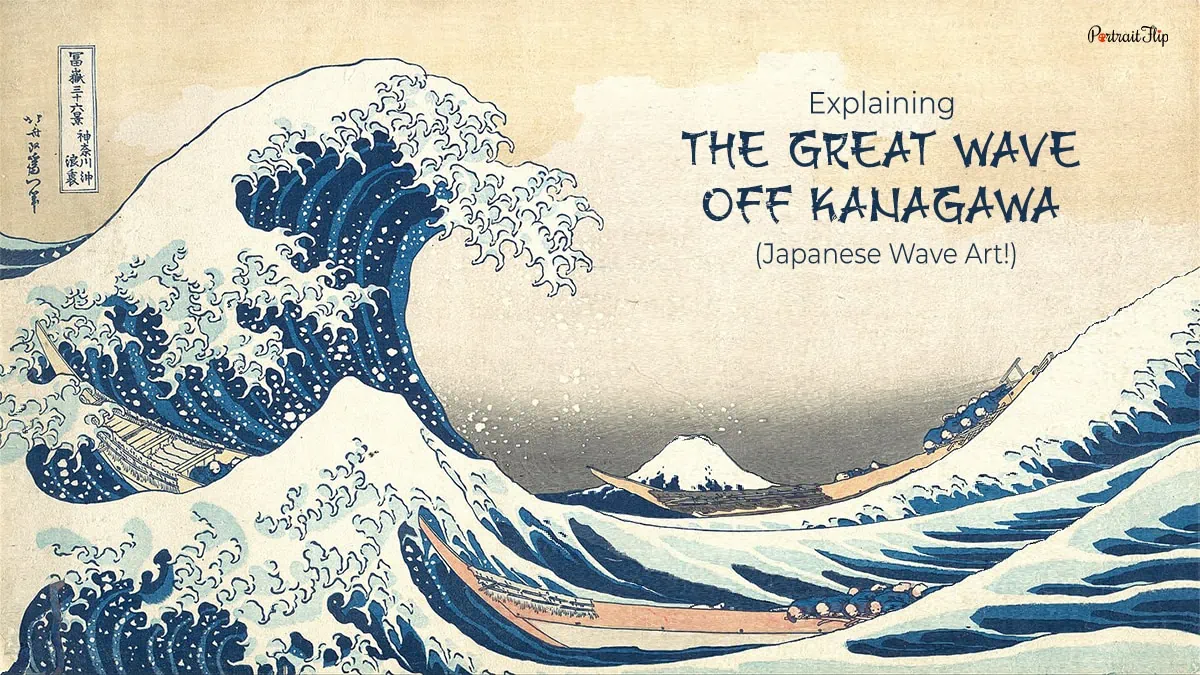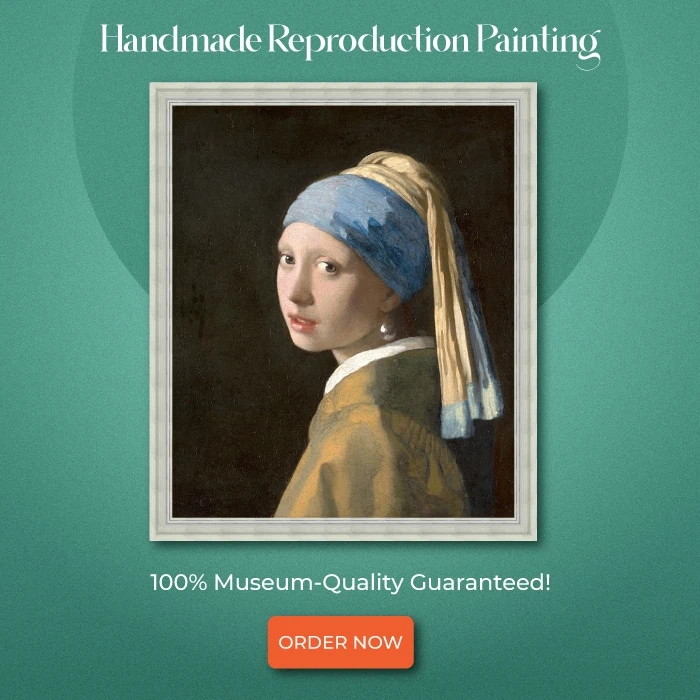In a mood for some stories?
Then let me start my blog by narrating an interesting backstory about a country.
1639 was the year when a nation closed its borders and entirely disconnected itself from other countries.
Western culture was banned, foreigners were dismissed, and entering or leaving the state became a punishable act.
This culture continued for over 200 years or so.
Do you have a slight idea about which place I’m referring to?
The country was Japan!
When the rest of the world was industrializing, Japan was concerned about foreign invasions.
You must be wondering why I am telling you the story about Japan being closed off and how it is related to the topic.
Well, under these episodes, Japanese artists developed art that engrossed people on a remarkable scale.
This gave birth to the masterpiece “The Great Wave off Kanagawa” by Hokusai in 1830.
In this blog, we will be discussing the ins and outs of this wave painting by Hokusai and the influences it had later on.
So, fasten your seat belts to explore the most recognized art, which includes some intriguing stories about Japan and its people.
How about we begin with a story about why Japan separated from the rest of the world?
Don’t you want to know the reason behind this unusual action?
Table of contents
Why was Japan a “Closed Country?” – The Edo Period
The tale begins with the Edo period, introducing both the city of Edo (currently known as Tokyo) and a time period.
The first Tokugawa Shogunate took over Japan in 1603.

He believed that foreign influence and Christianity in particular were threats to the new steadiness of the country (Japan).
Therefore, he detached himself from the world.
Strict orders were imposed, and the population was divided into classes—samurai, farming peasants, artisans, and finally merchants.
Emporers, court nobles, and shoguns were at the top.
The interaction was forbidden among the classes with strict rules of public behavior.
As the economy grew, the merchants, who were considered the lowest among the classes, rose and could afford luxuries like travel within Japan, education, and art.
They even sought sensual pleasures and became known as the ukiyo (floating world).
Kabuki theaters, puppet shows, writers, and poets started to grow in the country.

As the saying goes, “it is sex and celebrity that get sold.”
The commercial prints were all about famous Kabuki actors.
Woodblock prints (ukiyo-e prints) were selling in thousands.
With the constant demand for new images or celebrities, the prints were increasing like crazy.
Do you know which became the highly produced print?
Of course, what else if not “The Great Wave Off Kanagawa?”
The wave painting was printed at least 8,000 times. It’s incredible, isn’t it?
Now you know how the art in Japan became so popular!
Knowing Katsushika Hokusai: The Artist

To understand the art, we first need to learn about the painter of wave art.
After all, we got the opportunity to talk about the Great Wave off Kanagawa because of this brilliant man, Katsushika Hokusai.
Born in 1760, Hokusai made his reputation as a teenager by painting portraits of Kabuki actors with the help of woodblock prints.
After a while, he moved from painting celebrities to creating landscape artwork.
He started developing images based on the daily lives of Japanese people.
This change in subject was a breakthrough in Hokusai’s career.
His work and ideas made him one of the most famous artists in Japan.
Do you know a fascinating thing about Japan?
In Japan, the belief is that after the age of 60, you’re reborn.
This time brings celebration, rather than seen as getting old.
When Hokusai reached 70, he started developing the most celebrated painting of his time.
He himself said once, “All I have done before the age of seventy is not worth bothering with.”
He began his well-known aspiring project, “36 Views of Mount Fuji.”

“The Great Wave Off Kanagawa” was the first print art that belongs to his 36 Views of Mount Fuji series.
With this thought, let’s jump straight to the Great Wave Off Kanagawa description!
Exploring Art: The Great Wave Off Kanagawa
| Created in | 1831 |
| Period | Ukiyo-e or Edo Period |
| Medium | Woodblock prints and ink on paper |
| Genre | Marine Art |
| Housed in | Metropolitan Museum of Art |
| Estimated Price | Record of $2.76 million at a Christie’s auction |
| Dimensions | 25 cm x 37 cm |
If I tell you that what you are witnessing is not all Japanese art but a slight mixture of European ideas as well, then how will that make you feel?
You read it right!
Hokusai’s The Great Wave Off Kanagawa (also known as Under the Wave Off Kanagawa) is a hybrid of Japanese and European ideas.
How?
Despite the fact that the gates of Japan were completely shut for the other countries, the Dutch were allowed two trading ships per year.
This was the only direct connection with Japan and Europe.
During this time, Hokusai came to witness the Dutch landscape prints, which had a major influence on him.
This is the reason why “The Great Wave off Kanagawa” is not all Japanese.
Hokusai experimented with typical Dutch landscapes and created a famous Japanese wave painting.
How about a quick view of some interesting facts about painting the Great Wave?
10 Things You Need to Know About Famous Wave Art

- Although people mention this art as wave painting, it’s woodblock print art. It’s a print work, not a painting. Still, it is one of the hardest ways to paint, which I’ve explained in the later topic “What is Ukiyo-e Print?”
- The sea may captivate viewers with its wild and violent waves but the main subject of the painting is the mountain, which you can notice in the far distance.
- We cannot guess the exact age of when Hokusai created the wave painting but the belief is he was in his 70s.
- The art inspired an emoji. The wave emoji in phone resembles to the art, which is clearly visible in Apple’s version (incorporated in 2008). The emoji can be witness like this “🌊”
- People has assumption about art symbolizing as tsunami. But sometimes what our eyes see is not true. The studies say that the violence in waves is caused by rogue waves and doesn’t represent a tsunami.
- The dark shades around the mountain give the viewer an idea of the morning scenes.
- Hokusai’s Great Wave Off Kanagawa was the most reproduced art during that period of time (5000–8000 times)
- Before creating this Japanese wave painting, Hokusai produced two pieces of print art that later served as inspiration for this wave artwork. You can examine both pieces below.

- Hokusai’s work was displayed at the International Exposition in Paris (1867), which was admired by many fine artists like Vincent Van Gogh and Claude Monet.
- Apart from the Metropolitan Museum of Art, which holds the original work, many museums hold wave painting reproductions.
Why not look at what a ukiyo-e print is and the process by which this famous painting of a wave was created?
Suggested read: Water Lilies by Claude Monet
What is Ukiyo-e Print?

Ukiyo-e printing was the biggest art genre in Japanese history.
It was in the form of woodblock prints and paintings that Japan adopted the Ukiyo urban culture.
The print usually revolved around arts and entertainment.
However, with time, it started to include subjects such as nature, landscapes, and animals.
There were different types of subject matter referred to in Japanese.
Some of them were:
- “Shunga,” meaning “pictures of spring.” Although spring in this scenario was another word for sex
- “Bijin-ga” refers to “beautiful women.” This includes the famous female celebrity.
- “Yakusha-e” meaning “actor prints,” were known actors from Kabuki theatre.
- “Kacho-ga” which refers to “flower and bird print.” It connects with nature.
If you ask me the meaning of ukiyo-e, then my reply would not be restricted to one answer.
You know why?
This is because the term ukiyo-e has different meanings.
It means, in Japanese, “image depicting the floating world.”
If you look from another perspective, their meaning is attached to Buddhist beliefs about a short life span.
It also refers to sorrow and the cycle of life, including death and rebirth. Some believe that “uki” means sadness and “yo” means life.
You must have noticed many times that I have mentioned the word “woodblock prints.”
This is because it is the primary process that involves the making of “The Great Wave off Kanagawa.”
Making of “The Great Wave off Kanagawa”

1st Step: Create a design of the Great Wave Off Kanagawa painting on thin paper—a block-ready drawing.
2nd Step: Glue the drawing to the wooden block and rub it down with an instrument called “baren” in order to stick it properly.
3rd Step: The carver then removes the paper and peels off the remaining ones with their fingers, leaving the mark and just the lines of the original picture on the block.
4th Step: The engraving process starts with the artist carving the lines into the wood in the most detailed way.
5th Step: Add the prussian blue color to the woodblock.
6th Step: Place paper on the woodblock and use a baren to get the print in a proper way.
7th Step: Remove the paper slowly from the woodblock print and therefore, “The Great Wave off Kanagawa” is in front of you.
The above image is an illustration for you of how the process works.
I’ve mentioned before that it is one of the hardest ways to create art.
What do you think now after knowing the struggle behind this great work of art?
It’s not as easy as lifting a brush to paint, right?
Were you thinking of getting a replica of this wave painting but now the process scares you?
No worries; what is PortraitFlip for? We create reproductions of famous artworks that give them an authentic appearance.
Witness with your own eyes and order one for yourself now!
Overview of the Wave Painting
Talking about subjects makes the art more clear and interesting.
So, here I am with the analysis of the Great Wave Off Kanagawa!
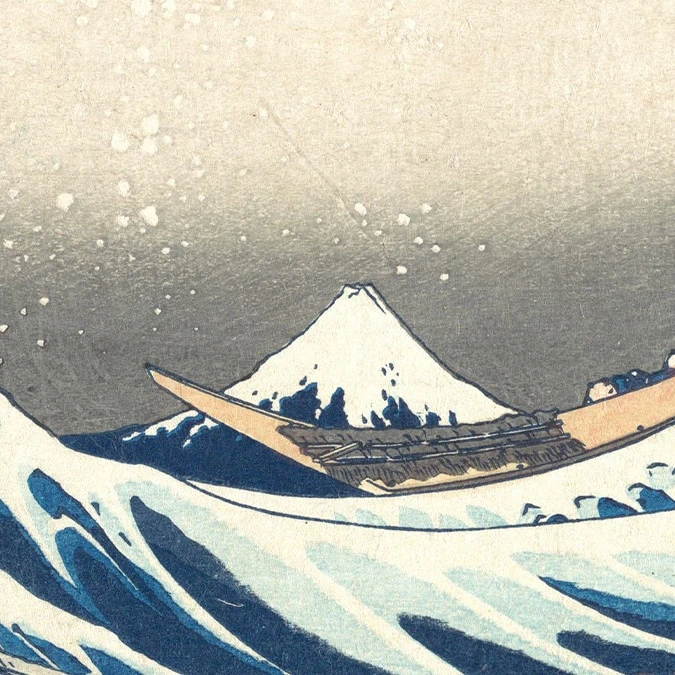
a) Mountain: The Snow-Capped Mount Fuji
The mountain you witness in the art is none other than the famous “Mount Fuji.”
Mount Fuji is sacred in Japan, with over 800 holy places dedicated to it.
It was a spiritual obsession for the Japanese.
It was also seen as a significant symbol of strength and stability in Japan.
Hokusai, known for depicting nature, chose Mount Fuji as his primary subject.
As a result, he created “36 Views of Mount Fuji,” which you already read above.
The scene depicts the mountain seen from different angles.
From the village to the forest, from rivers to lakes and beaches.
However, “The Great Waves Off Kanagawa” made a huge impact internationally and was considered the most famous Japanese wave art.
Image: metmuseum
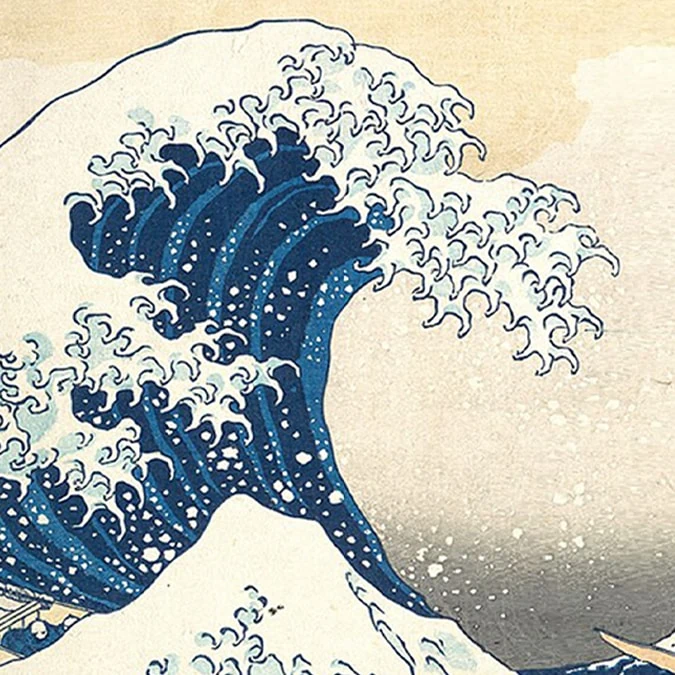
b) Sea Waves
When you search “famous Japanese painting of waves,” you get tons of this blue water picture in front of you.
Waves seem to be the highlight of the art, which makes Hokusai the most recognized Japanese wave artist.
Give it a closer look; it seems as if those white little claws are on the verge of grabbing the men in boats.
Due to their size, they seem to be violent and fierce.
It creates a certain movement in art.
We can also notice the smaller waves filling up the ground, creating a theatrical scene.
Have you ever wondered what happened to the men in the boats?
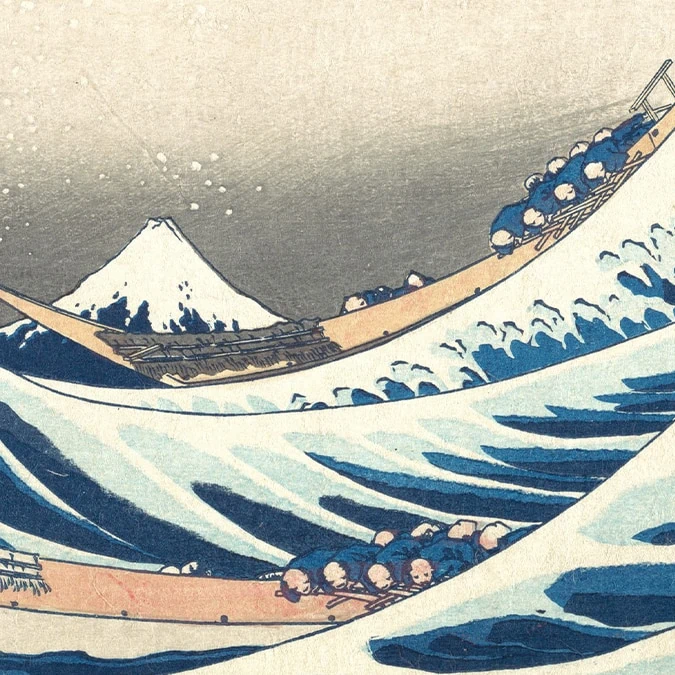
c) Men in Boats
We observe three boats filled with men who are stuck in these giant waves.
There are eight rowers in each respective boat and all the figures are similarly dressed in dark blue.
We could see the struggle of the men as they were about to hit a massive wave.
An interesting fact about the boat is that it is referred to as an oshiokuri-bune boat, which was used in Japan for fishing.

d) Name Stamp
The signature you notice in the upper-left corner of Katsushika Hokusai The Great Wave Off Kanagawa translates to “Hokusai aratame litsu hitsu.”
The meaning of this translation reads, “From the brush of Hokusai, who changed his name to Iitsu.”
Basically, Hokusai used to change his name frequently.
This is one of the reasons why the inscription reads in such lines.
There is one common factor that was used in creating art. Can you guess?
It’s the color—Prussian blue!
Let me elaborate.
Suggested read: Impression, Sunrise by Claude Monet
The Ink Print Art (Reviewing the Texture)
a. Color: Prussian Blue

Have you heard about this color before?
Prussian blue, an expensive synthetic color, was introduced in 1829.
China made it possible for the Japanese to buy the color at a lower price and use it in ukiyo-e prints.
In 1706, the shade was discovered by the Berlin printmaker Johann Jacob Diesbach.
It was also known as “Berline Blue.”
The shade has vivid and tonal effects.
You know the best part about Prussian Blue? It never fades away.
Different shades of Prussian blue could be seen in each of Hokusai’s works.
The demand for this shade increases after the painting of the waves.
b. Scale and Perspective
As I mentioned before, the size of the Great Wave Off Kanagawa Hokusai utilized space.
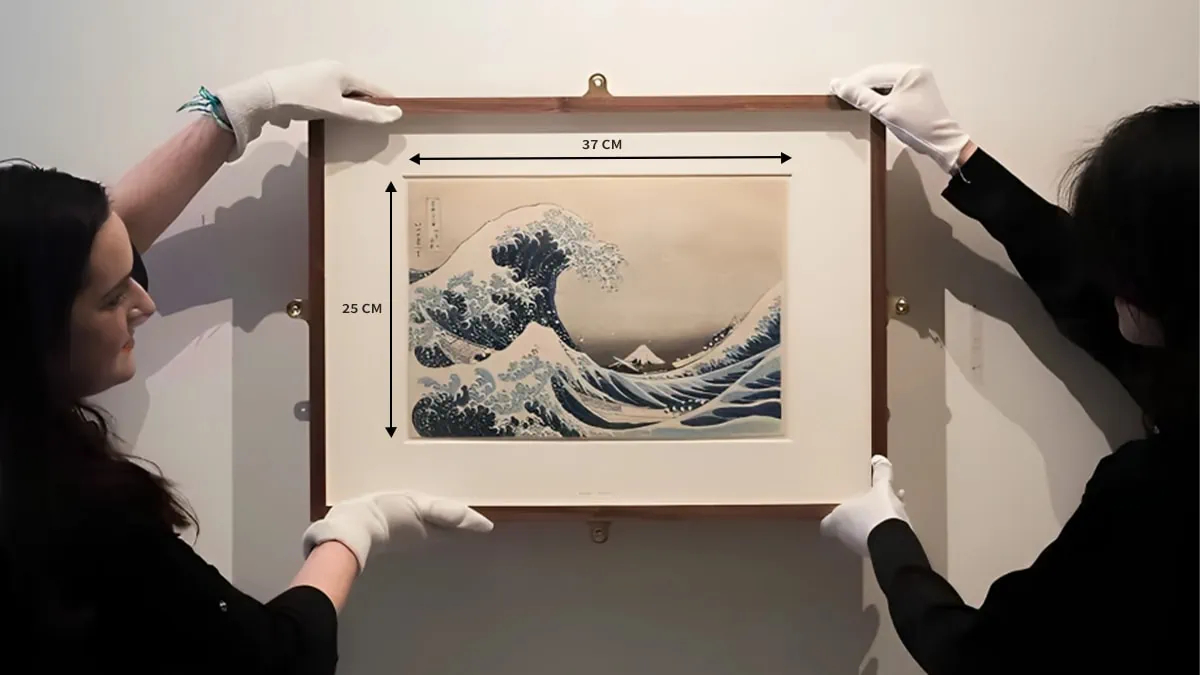
Hokusai presents the scene in front of his admirers from a semi-aerial vantage point.
From a viewpoint, it seems slightly uplifted, which gives a bird’s-eye view of the painting.
It also creates a sense where the audience feels that the men in the boat are about to be crushed by the big wave approaching them.
But, as you already know, it’s not a tsunami; the story behind it is something else.
It continuously drives the attention of its viewers with it’s curving motion.
The viewer also gained a new perspective on Mount Fuji and the distance at which it is situated.
Surely a masterpiece!
Suggested read: Chinese Art
Impact on Western Culture
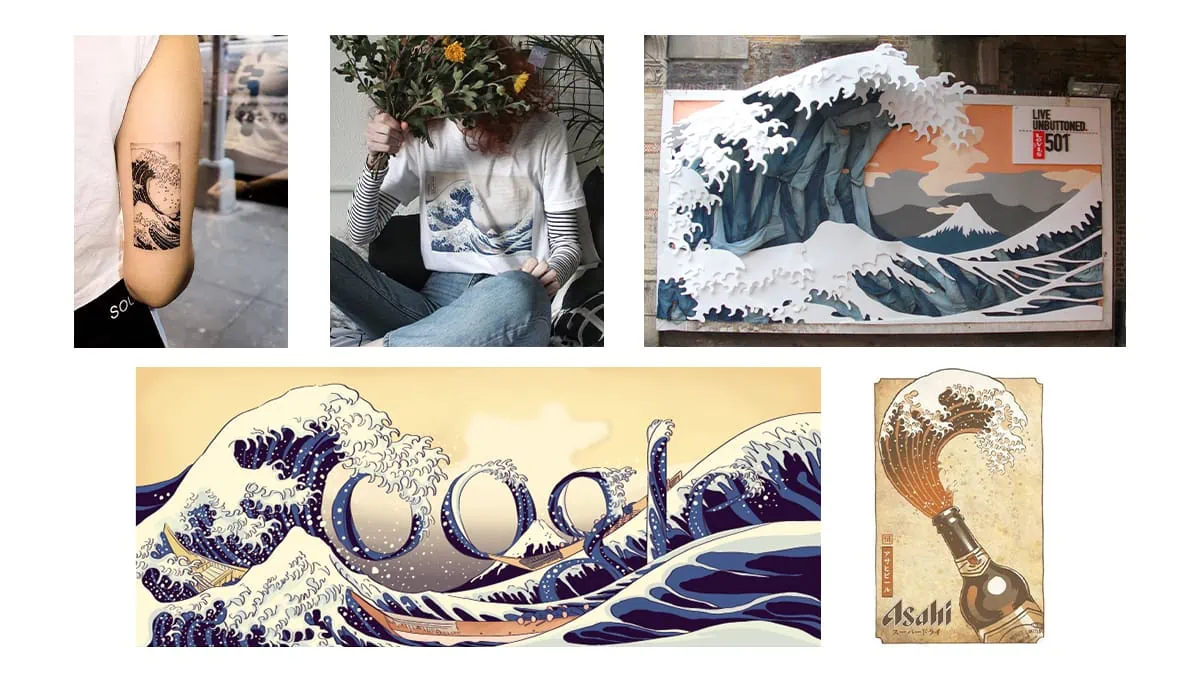
Business is made by the audience and the people who get influenced by certain things.
“The Great Wave Off Kanagawa” was one of them.
Where cultures like pop art paintings were growing, “The Great Wave Off Kanagawa” was alone, leaving an impact on western culture.
Just look at the image above.
Whether it is selling beers, clothes, or tattooing oneself, the art has an affect on everyone.
Google was not so far behind in portraying the wave painting.
It used for a variety of ends.
I could only present a glimpse of some of the influenced Japanese wave artwork.
There are several representations of Hokusai’s wave painting that could flood this blog with pictures.
Lastly
I would like to end with an interesting fact about the great wave painter, Hokusai.
Being on his deathbed, he said that he wanted a few more years as an artist.
The words he spoke were somewhat like, “If only heaven will give me just another ten years… Just another five more years, and then I could become a real painter.”
You must be wondering, after being a spectacular artist, why he had this thought.
Well, it is believed that Hokusai has doubts about his abilities.
As an artist, he has still not painted the best, or he needs more practice.
There can be many interpretations.
But today’s reality is that he created a famous Japanese wave painting that will always be remembered!
How My Readers Doing?
What an intriguing topic to share, isn’t it?
I hope you loved it too and gained the information you were looking for.
Suggesting, questioning, and any extra information related to the topic are open for you all in the comment section.
If you want to know more about paintings and hear fascinating stories, then I welcome you to our artwork analysis page.
It is full of mysteries, stories, and histories of different paintings.
I would leave you to explore the page and get back with my next piece soon.
As I always say, till then, keep reading and exploring!
FAQs
“The Great Wave Off Kanagawa” is renowned as it represents a symbolic picture of the changes occurring in Japanese society.
Katsushika Hokusai is the artist of The Great Wave Off Kanagawa.
In 1831 “The Great Wave Off Kanagawa” took place.
The Metropolitan Museum of Art holds original Japanese wave art.



